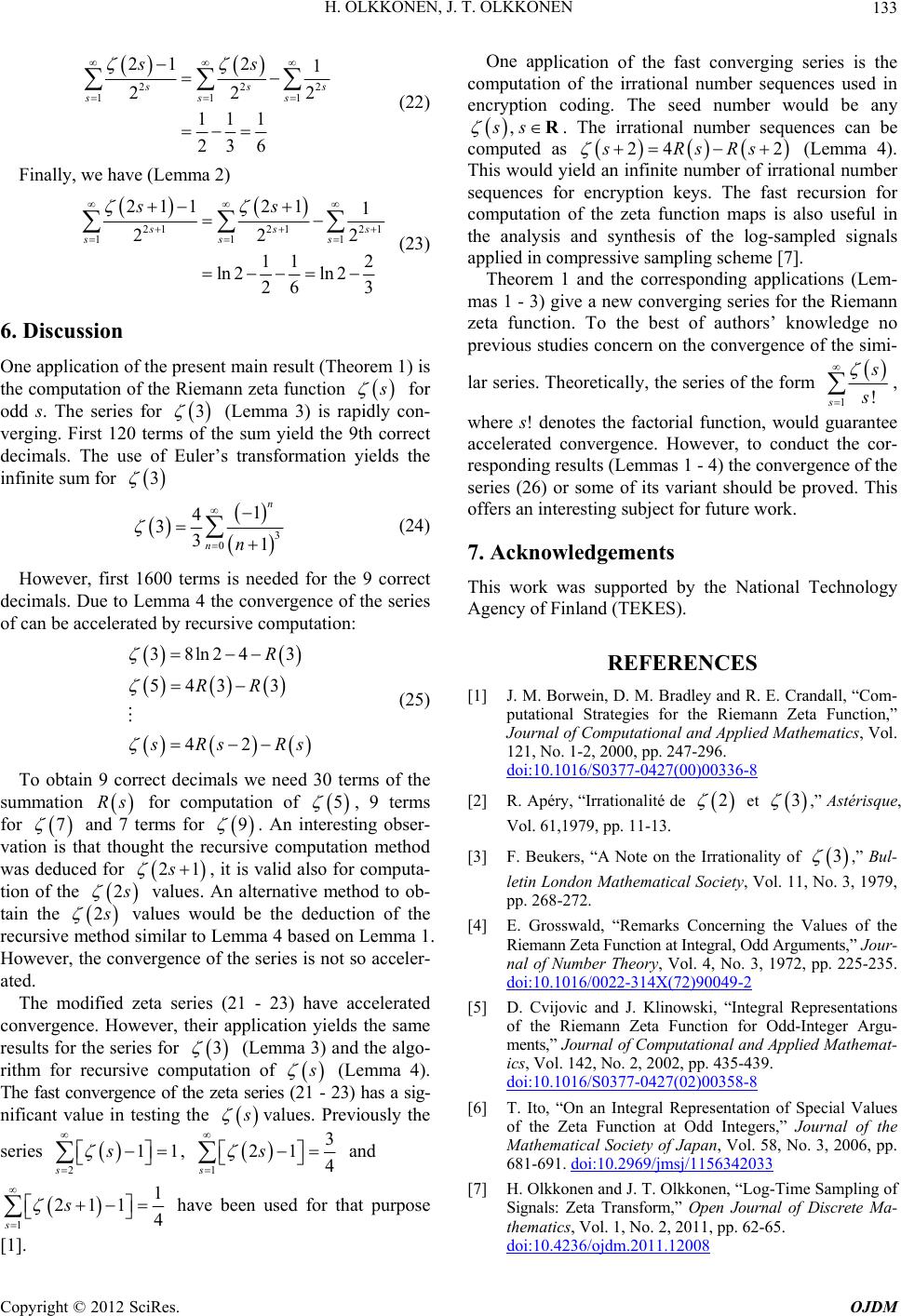
H. OLKKONEN, J. T. OLKKONEN
Copyright © 2012 SciRes. OJDM
133
22
11
212 1
22
2
1
2
23 6
11 1
ss
sss
ss
(22)
Finally, we have (Lemma 2)
2121 21
11
211 21
1
22
2
11 2
ln 2
26 3
sss
sss
ss
(23)
6. Discussion
One application of the present main result (Theorem 1) is
the computation of the Riemann zeta function
1
ln 2
rapidly
h corr
for
for (Lemma 3) is con-
erme sum yield the 9tect
odd s. The series
verging. First 120 t
3
s of th
decimals. The use of Euler’s transformation yields the
infinite sum for
3
3
0
1
4
331
n
nn
(24)
However, first0 term 160s is needed for the 9 correct
decimals. Due to Lemma 4 the convergence of the series
of can be accelerated by recursive computation:
38ln24 3
42
R
54
3 3RR
Rs Rs
(25)
To obtain 9 correct decimals we need
summation for computation of
for ms for
30 terms of the
5
, 9 terms
Rs
and 7 ter
7
9
e recursiv
. Ang ob
vaht the comn method
w
interestin
putatio
ser-
tion is that thoug
2
as deduced for
21s
, it is valid also for computa-
tion of the
values. An alternatethod to ob-
he
2
i
tain
ve m
t
values d be the deduction of the
recursive method similar to Lemma 4 based on Lemma 1.
However, the conof the series is not so acceler-
ated.
The mo zeta series (21 - 23) have accelerated
convergence. However, their application yields the same
results for the series for
3
(Lemma 3) and the algo-
rithm for rec
woul
vergence
dified
ursive comof putation
(Lemm
Th
a 4).
e fast convergence of the zeta series (21 - 23) has a sig-
nificant value in testing the
values. Previously the
series
2
11
s
s
,
1
3
21
4
s
s
and
1
1
211 4
s
s
have used for that purpose been
[1].
lication of the fast converging series is the
tation of the irrational number sequed in
encryption coding. The seed number would be any
One app
compunces use
,ss
R
computed as
. The irrational number sequences can be
24 2sRsRs
eld an infinite number of irrat
(Lemma 4).
iional number
se
applied in co
nd the corresponding appli
This would y
quences for encryption keys. The fast recursion for
computation of the zeta function maps is also useful in
the analysis and synthesis of the log-sampled signals
mpressive sampling scheme [7].
Theorem 1 acations (Lem-
mas 1 - 3) give a new converging series for the Riemann
zeta function. To the best of authors’ knowledge no
previous studies concern on the convergence of the simi-
lar series. Theoretically, the series of the form
1!
s
where s! denotes the factorial function, would guarantee
accelerated convergence. However, to conduct the cor-
responding results (Lemmas 1 - 4) the convergence of the
series (26) or some of its variant should be proved. This
,
NCES
ley and R. E. Crandall, “Com-
nd Applied Mathematics, Vol.
.
doi:10.1016/S0377-0427(00)00336-8
offers an interesting subject for future work.
7. Acknowledgements
This work was supported by the National Technology
Agency of Finland (TEKES).
REFERE
[1] J. M. Borwein, D. M. Brad
putational Strategies for the Riemann Zeta Function,”
Journal of Computational a
121, No. 1-2, 2000, pp. 247-296
[2] R. Apéry, “Irr,” Asté risque, ationalité de
2
et
3
Vol. 61,1979, pp. 11-13.
[3] F. Beukers, “A Note on the Irrationality of
3
,” Bul-
letin London Mathematical Society
pp. 268-272.
, Vol. 11, No. 3, 1979,
ol. 4, No. 3, 1972, pp. 225-235.
[4] E. Grosswald, “Remarks Concerning the Values of the
Riemann Zeta Function at Integral, Odd Arguments,” Jour-
nal of Number Theory, V
doi:10.1016/0022-314X(72)90049-2
[5] D. Cvijovic and J. Klinowski, “Integral Representations
of the Riemann Zeta Function for Odd-Integer Argu-
ments,” Journal of Computational and Applied M athe mat-
ics, Vol. 142, No. 2, 2002, pp. 435-439.
doi:10.1016/S0377-0427(02)00358-8
[6] T. Ito, “On an Integral Representation of Special Values
of the Zeta Function at Odd Integers,” Journal of the
Mathematical Society of Japan, Vol. 58, No. 3, 2006, pp.
681-691. doi:10.2969/jmsj/1156342033
[7] H. Olkkonen and J. T. Olkkonen, “Log-Time Sampling of
Signals: Zeta Transform,” Open Journal of Discrete Ma-
thematics, Vol. 1, No. 2, 2011, pp. 62-65.
doi:10.4236/ojdm.2011.12008